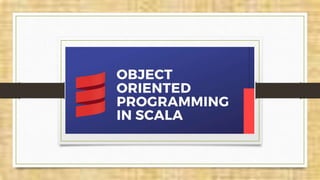
Unit-4 Day1.pptx
- 2. UNIT - IV Abstraction and Encapsulation Abstraction: Abstract Methods - Abstract Class and its importance – implementation of abstraction – Encapsulation: Packages - Access Modifiers – application of encapsulation - Type Class and Conversions.
- 3. Abstraction ⮚Abstraction is the process to hide the internal details and showing only the functionality. ⮚In Scala, abstraction is achieved by using an abstract class. ⮚an abstract class is constructed using the abstract keyword. ⮚Abstraction can be achieved in two ways. ⮚Abstract method ⮚Non-abstract method ⮚Interface
- 4. Abstraction
- 5. Abstract Methods • The abstract methods of abstract class are those methods which do not contain any implementation. Or in other words, the method which does not contain body is known as an abstract method. Syntax: abstract class class-name{ def method-name() }
- 6. Non-abstract Methods • These methods are those methods that define their implementation as well at the time of declaring themselves. They contain their body that means the actual logic inside them, so we can say that this logic is not hiding with the user because we are providing the implementation so they cannot give us full abstraction. • Syntax: abstract class class-name { def method-name(){ // you can write your logic here } }
- 7. Interface • using the interface we can achieve 100% abstraction. In Scala, we use trait keyword to define an interface • Syntax: trait class-name { def method-name(): Unit def method-name(): Unit }
- 8. Examples of Scala Abstract Class • We have one Bank as a parent bank for all its sub banks. But the benefits they are providing to their customers vary from each other like the rate of interest they are giving is different from bank to bank. so, in this case, we can have our print class as Bank and all other child classes are like SBI, ICICI, IDBI, BOI, and many more.
- 9. Difference Between Traits and Abstract Classes in Scala • In Scala, an abstract class is constructed using the abstract keyword. • It contains both abstract and non-abstract methods and cannot support multiple inheritances. • Traits can have methods(both abstract and non-abstract), and fields as its members. • Traits are just like interfaces in Java. • But they are more powerful than the interface in Java because in the traits we are allowed to implement the members.
- 10. Difference Between Traits and Abstract Classes in Scala
- 11. Packages Package in Scala is a mechanism to encapsulate a group of classes, sub packages, traits and package objects. It basically provides namespace to put our code in a different files and directories. Packages is a easy way to maintain our code which prevents naming conflicts of members of different packages.
- 12. Packages
- 13. Declaration of Package Packages are declared as a first statement at the top of a Scala file. Syntax : package package_name // Scala classes // traits // objects..
- 14. Defining a package Defining a package can be done in different ways:- Chained methods package x.y.z // members of z or can be used as:- package x package y package z // member of z
- 15. Defining a package Nesting packages package x{ // members of x {as required} package y{ // members of y{as required} package z{ // members of z{as required} } } }
- 16. How Package works Packages binds together the data in a single file or works as data encapsulation, when a file is saved it comes under default package or under a package name as specified at the top of the file. For example if a package name is college.student.cse, then there will be 3 directories, college, student and cse. Such that cse is present in student and student is present in college.
- 17. Different ways to use import statements 1. Importing all public members of package. import college._ //imports all college members students, faculties, houseKeeping etc. 2. Imports only selected members of a package. import college.{faculty, houseKeeping} //member student is not selected hence cannot be used in current file 3. Imports and rename the members. import college.{student => stu} //stu is used in-place of student
- 18. Case Study - DIY
- 19. Access Modifiers we can restrict the members from being accessible to certain areas of the code.
- 20. Private Modifiers Private members are available only inside the class or to the object containing the member definition. The private access modifier can be used for variables and methods as well.
- 21. Protected Modifiers Protected members can be accessed from subclasses of the class in which the member is defined (inherited class). This can also be used for methods as well as variables.
- 22. Public Modifiers The default access modifier is public. When the keywords private or protected is not specified then the members are treated as public by the compiler and we don’t have to explicitly specify the keyword “public”. https://www.simplilearn.com/tutorials/java-tutorial/java-encapsulation https://www.scientecheasy.com/2020/07/encapsulation-in-java.html/